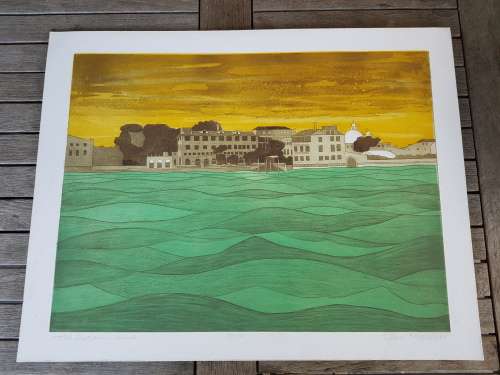
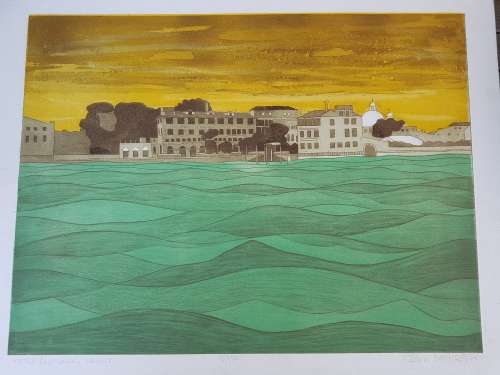
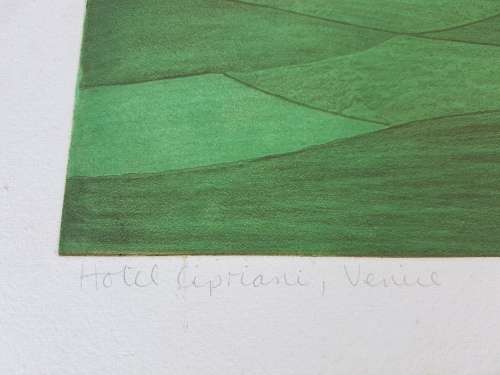
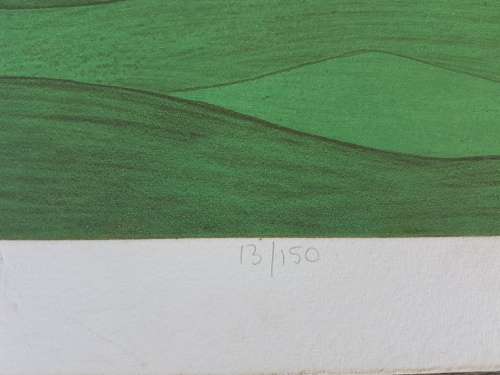
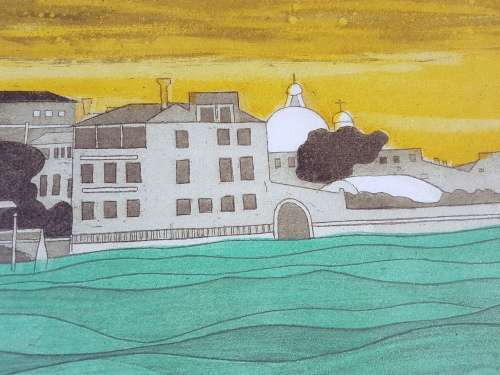
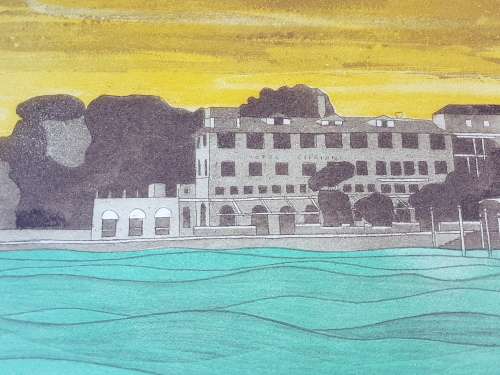






John Brunsdon (1933-). Hotel Cipriani, Venice. Limited Edition Etching with Aquatint. 13/150.
Check my rate
| Main centres: | 1-3 business days |
| Regional areas: | 3-4 business days |
| Remote areas: | 3-5 business days |












| Main centres: | 1-3 business days |
| Regional areas: | 3-4 business days |
| Remote areas: | 3-5 business days |
Etching is 60 x 47 cm. On card 69 x 54 cm.
Terrific colours. Hand signed and numbered 13/150.
John Brunsdon is one of England's top printmakers. On card 54 x 69 cm.
This particular limited edition etching is one of his rarer examples and was commissioned in 1977 by Sea Containers, who bought the Hotel Cipriani. It is one of the top hotels in Venice, Italy and the world, a short motor boat ride across the water from St. Mark's Square. Room rates start from $1450 per night.
Will be packed flat and sent Postnet to Postnet for R99. Will be sent registered airmail to overseas buyers at cost. Or you can use your own courier. Or you can pick it up.
Brunsdon is interested in man's influence upon the landscape, the contrast between architecture and the countryside and the way in which man has sculpted the surface for his own use. His characteristic style reflects his acute understanding of the etching process. Meticulous craftsmanship is his hallmark. He takes pleasure in the robust textural and decorative qualities of the etched marks and the sweeping shapes of broad colour, which fuse into relaxing timeless images. The poetic instinct could not be more in focus.
It is not surprising then that there is a link with the Neo-Romantic tradition of John Piper, Paul Nash and Graham Sutherland. Brunsdon's Betjemanesque anglicanism may be seen in his plates for both Norwich and Ely Cathedrals (1990). As with Paul Nash, Brunsdon's poetic and, to a lesser extent, mystical vision, is nourished by ancient or primeval sites as seen in Stonehenge (1977) and Avebury (1979). Earlier works of the 1960's were decidedly abstract in form and reflected the American Abstract-Expressionists. Celtic Cross (1962), Dawn (1964) and Creen Obelisk (1966) are typical images which evoke an inner world and spiritual awakening.
After Cheltenham Grammar School and encouragement from his art master, Brunsdon enrolled at the Cheltenham School of Art in 1945, then under the direction of Stanley Dent, an etcher of some standing who had been taught at the Royal College of Art by Robert Austin. Austin in turn had been instructed by the influential Sir Frank Short. All three, Short, Austin and Dent had practised the tradition of working direct on the plate from nature. Dent was a lover of rural England and could be seen working at his Gloucestershire locations. Brunsdon, however, has never worked directly from nature. His method is to draw and photograph the subject and work out ideas in the studio.
Although Dent undoubtedly provided inspiration, it was Julian Trevelyan at the Royal College of Art, who, more than anyone else, provided a vigorous arid fundamental influence. It was Trevelyan who had opened up colour etching and aquatint after the post-waryears. Artists had, in the main, produced black and white etchings which were hand watercoloured if so desired. Trevelyan chose to ink his etched plates with separate colours. Each colour applied to the appropriate area with a small piece of muslin. The image was printed and the process repeated for the next print. This is the method used by Brunsdon. It is time consuming and requires considerable skill in applying the colour evenly and accurately to stop smudging.
Brunsdon developed this technique and began to experiment with remarkable colour combinations. Yellow skys, vermillion frees and blue grass. Mixtures to heighten the senses. He had transformed the traditional approach to etching. The conjunction of colours possessed, and still possess, a special magic for Brunsdon.
1933 Born in Cheltenham , Gloucestershire, 1949: Studied Cheltenham College of Art painting, drawing and etching under Stanley Dent arid Ken Oliver for four years. First noticed the paintings and etchings of Julian Trevelyan, whom he admired, at an exhibition of British Contemporary Art held in Cheltenham .1955: Studied etching at the Royal College of Art for three years. Contemporary with Robyn Demiy and Alan Green. Having been interviewed and accepted by Robert Austin two years previously, it was a revelation to find Julian Trevelyan had become Head of Etching. Other teachers included Edwin La-Dell, Alaster Grant, Edward Ardizzone and Edward Bawden. His own work now influenced by the American Abstract- Expressionists.
1964: Published The Technique of Etching and Engraving, Batsfords.
1967: First one man exhibition in Britain at the Curwen Gallery, London .
1973: At the invitation of David Case he becomes one of the first artists to join Christie's Contemporary Art. With Edward Bawden, David Gentleman and Gerd Winner he is represented in The Daily Telegraph Magazine, November Issue No. 474, The British Landscape, CCA.
1975: First one exhibition in the United States of America at the Alice Simsar Gallery, Ann Abor, Michigan .
1977: Moves to Stradbruke, Suffolk . Retires from teaching to concentrate on etching. The landscape of Suffolk and Norfolk now features in his work. Also the ancient sites of Stonehenge and Avebury. Commissioned by James Sherwood, Sea Containers, for twelve plates of Venice for the Hotel Cipriani. A number of commissions are established from now on, including the National Trust.
1982: First one man show in Europe at the Galarie L'Angle Aigue, Brussels .
1984: First one man exhibition in Australia at the Chapman Gallery, Canberra .
